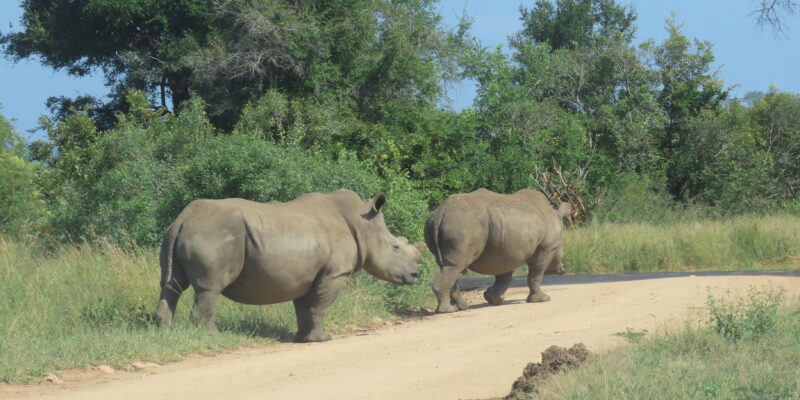We couldn’t be more thrilled to share the video above of the rhinos we spotted in Kruger National Park. With so many rhinos having been poached in South Africa’s national parks, there are few remaining rhinos, as mentioned in a post from several days ago, found here.
Today, we are sharing some interesting facts about rhino behavior that we’ve never posted in the past, which may be of interest to some of our wildlife enthusiast readers and friends.
Rhino Behavior: A Closer Look at the Lives of Earth’s Armored Giants
Rhinoceroses, often perceived as solitary, grumpy, or aggressive, are far more nuanced and engaging in their behavior than many people realize. These ancient herbivores, which have roamed the Earth for millions of years, display a range of complex behaviors that reflect their evolutionary adaptations, environmental pressures, and social tendencies. Spread across Africa and Asia, the five species of rhino—white, black, Indian, Javan, and Sumatran—each exhibit unique patterns of behavior, though they also share many common traits.
One of the most defining aspects of rhino behavior is their territoriality. Adult males, particularly among black and white rhinos, tend to be highly territorial. They mark their territories with dung piles called middens, and also use urine spraying to define boundaries. These signs are not just about marking territory; they’re a form of communication. Other rhinos can learn a great deal from these markers, including the age, sex, and reproductive status of the individual who left them.
Despite their size and strength, rhinos are generally solitary creatures, especially the black and Sumatran species. Adult males are typically the most solitary, while females may be accompanied by their calves for several years. The white rhino is the most social of the species, often forming small groups called crashes. These can consist of females and their offspring, as well as occasionally, subadult males. Even among more solitary species, social interactions do occur, particularly during mating or when young males begin to establish themselves.
Communication among rhinos is surprisingly varied. While they are not known for vocalizing often, rhinos do use grunts, snorts, and bellows to express alarm, frustration, or even affection. Calves will usually squeal or whimper when separated from their mothers. Body language is also essential. For instance, a rhino holding its head high and ears forward may be alert or curious, while a lowered head with flattened ears can be a sign of aggression or defensiveness.
Aggression is a part of rhino behavior, especially when territory or mating rights are at stake. Male rhinos often engage in fierce battles, using their horns, which can sometimes result in serious injury or death. These fights serve a purpose beyond just winning a mate—they help establish dominance and define territorial boundaries. That said, most confrontations are avoided through display behaviors and posturing, which serve as warnings.
Rhinos are also creatures of habit. They follow regular paths to waterholes and feeding grounds, and tend to rest during the hottest parts of the day, becoming more active in the early morning and late afternoon. Wallows—muddy pools where rhinos roll and coat themselves in mud—are an essential part of their daily routine. This behavior not only cools them down but also protects their skin from parasites and sunburn.
Interestingly, rhinos share their environment with other animals in ways that influence their behavior. In Africa, for example, oxpecker birds are commonly seen perched on rhinos’ backs, feeding on ticks and warning them of danger with sharp cries. While the rhinos appear indifferent, this relationship hints at a subtle interdependence within their ecosystem.
Though rhinos are often portrayed as simple or primitive animals, their behavior reveals a deeper complexity. Their ability to communicate, form social bonds, adapt to environmental stressors, and navigate intricate territorial dynamics is a testament to their intelligence and resilience. Understanding rhino behavior not only deepens our appreciation for these magnificent creatures but also plays a crucial role in conservation efforts. By respecting their space and recognizing their needs, we can help ensure that rhinos continue to roam wild landscapes for generations to come.
Late this afternoon, the three of us will head to Amazing Kruger View to check for wildlife on the river and to have dinner. It’s hard to believe that Lisa is leaving in two days, after spending a month with us. We’ve so enjoyed her company and will miss her.
Be well.
Photo from ten years ago today, April 29, 2015:


